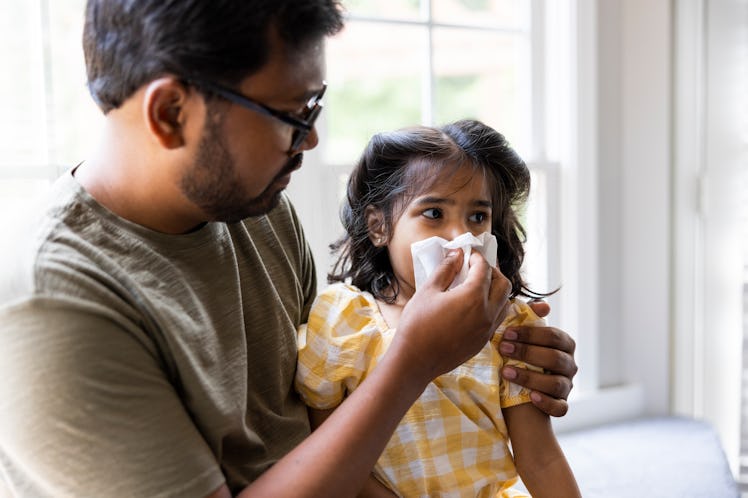RSV Season Is Back — And In Full Force For 2022
RSV is filling up hospitals fast. This is how you keep your kid safe.

For the past two winters, we’ve all been living in a bubble. As a result, our children haven’t been exposed to many of the viruses their immune systems would typically be used to fighting. That means as kids go back to school, daycare, birthday parties, theme parks — basically, normal life — and largely without masks, they’re being exposed to any number of viruses that they haven’t yet encountered.
This, according to experts, is part of the reason that emergency rooms across the nation are filling up fast with sick kids, many of whom have RSV. And as we move into late fall and winter, the problem is likely to only get worse. So parents need to be a little extra vigilant as we prepare for a rocky cold and flu season ahead. To do that, you have to have your head wrapped around RSV — and all the other illnesses you’re likely to encounter. Here’s what you need to know.
What Is RSV Again?
RSV stands for respiratory syncytial virus, and it’s a common respiratory illness that spreads through droplets, says Felicia Scaggs Huang, M.D., associate director of Infection Prevention and Control at Cincinnati Children’s Hospital Medical Center. You know, the same type of droplets that COVID spreads through. Although RSV is common in both children and adults, the virus can cause more serious issues in premature infants and young children under age 2, as well as immunocompromised people and children with underlying cardiovascular issues.
What RSV Season Looks Like In 2022
Over the past two years, we’ve experienced lifestyle changes that meant our immune systems weren’t encountering a normal viral load. In pre-COVID times, most kids would have had RSV by age 2. But because of the pandemic, many children haven’t yet been exposed, and so they don’t yet have immunity.
The first time a child contracts RSV, they’re likely to be more symptomatic. Usually, once kids get it again, it’s more like a cold. So RSV is bad right now not only because a lot of kids are getting it, but particularly because a lot of kids who have never been exposed to it before are getting infected for the first time and coming down with bad symptoms. In other words, not only are more kids getting sick, but they’re also getting sicker than usual.
Additionally, COVID-19 altered the seasonality of respiratory illnesses, says Scaggs Huang. We’re seeing more RSV cases and hospitalizations, and those cases are coming earlier in the season than in years past. While RSV had fallen off our radar because we were all focusing on COVID-19, now that we’re out and about, it’s back with vigor, Scaggs Huang says.
What Parents Need To Know About RSV
Almost all kids get RSV at some point in their lives, and for most, it’s similar to a common cold. Early symptoms of RSV usually include a runny nose, decreased appetite, cough, and fever. For many children, it stops there, says Scaggs Huang. But in more severe cases, the virus can cause bronchiolitis — a serious inflammation of the small airways and lungs — as well as pneumonia.
Severe RSV Symptoms To Look Out For
Most of the time, you can deal with RSV at home with supportive care: fluids, Tylenol, and rest. But if you start to notice that your child is having difficult breathing or a decreased appetite, these are indications of a more serious illness.
If a child isn’t drinking or eating and becomes dehydrated, see your doctor. If you have an infant and you haven’t seen a wet diaper in eight hours, that’s a sign they’re dehydrated.
According to Anh Le, M.D., a pediatrician at One Medical in Irvine, California, if parents notice any changes in breathing, it’s time to seek medical attention. If you notice that your child is working harder to breathe and is sucking in at the chest and neck, get to the emergency room immediately. Wheezing, trouble talking, or any signs of respiratory distress are all signs that your child needs emergency medical attention.
How To Protect Your Family From RSV
Unfortunately, there’s currently no vaccine for RSV, so much of the protection protocol is standard hygiene, says Le. Parents and kids should be washing their hands with soap and warm water throughout the day. They should also be more vigilant about cleaning surfaces and making sure that kids get enough sleep to keep their immune systems strong. And make sure children and adults are up-to-date on other vaccinations like flu and COVID-19.
Other Viruses On The Rise In Hospitals
Yes, we’re also seeing more cases of influenza earlier than usual this year. This means that it’s a good idea to go ahead and get yourself and your children their flu shots as soon as possible, Le says.
We’re also seeing more cases of cold viruses that are causing bronchiolitis and difficulty breathing, similar issues to those caused by RSV. In fact, many viruses this flu season seem to be leading to more serious symptoms than the common cold you usually think of.
We don’t usually see these viruses in the fall because we’re spending more time outdoors than in the winter, but this year is different. Just like with RSV, our immune systems haven’t been exposed to these viruses for a few years now.
It’s important to remember that kids are resilient, RSV, colds, and the flu usually aren’t too dangerous to children, and they generally bounce back really well.